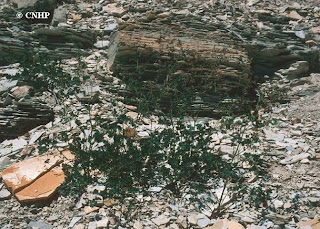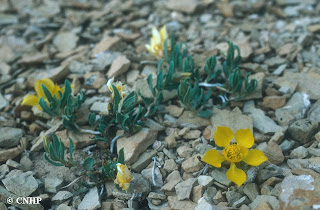This site was visited in 2000 as part of the Garfield County Inventory. This large site encompasses the Parachute Creek drainage as it descends from the top of the Roan Plateau toward the Colorado River west of Rifle. Here Parachute Creek and its tributaries have excavated a geologic section in sedimentary strata of the Tertiary Green River and Wasatch formations. Each tributary makes a dramatic plunge off the Roan Plateau over 100 to 200 foot shale cliffs.
Thalictrum heliophilum basking in the sun in its shaley habitat
The site supports numerous occurrences of several rare plants, including Roan Cliffs blazing star (Mentzelia rhizomata, G2/S2), Utah fescue (Argillochloa dasyclada, G3/S3), and sun-loving meadow rue (Thalictrum heliophilum, G3/S3), as well as an excellent example of a hanging garden of the type characteristic of the Utah High Plateau, dominated by hanging garden sullivantia (Sullivantia hapemanii var. purpusii).
Mentzelia rhizomata - the Roan Cliffs blazing star
South-facing slopes are dominated by sagebrush (Artemisia tridentata), serviceberry (Amelanchier), and mountain spray (Holodiscus dumosus), while Douglas-fir / spruce - fir (Psuedotsuga menziesii - Picea) forests cover north-facing slopes. The more gentle slopes dropping off the Roan Plateau support high quality grasslands and sagebrush shrublands. Although the canyon bottom has been heavily impacted by gas well development, there is lush riparian vegetation remaining in portions of the canyon, including examples of the globally vulnerable (G3/S2) box elder / chokecherry (Acer negundo / Prunus virginiana) montane riparian deciduous forest and the globally vulnerable (G3/S3) narrowleaf cottonwood / skunkbrush (Populus angustifolia / Rhus trilobata) riparian forest.






No comments:
Post a Comment
Thanks for your comment!
Please note that all comments are moderated, so there may be a delay of some hours (especially over the weekend or at night Colorado time) before your comment shows up.